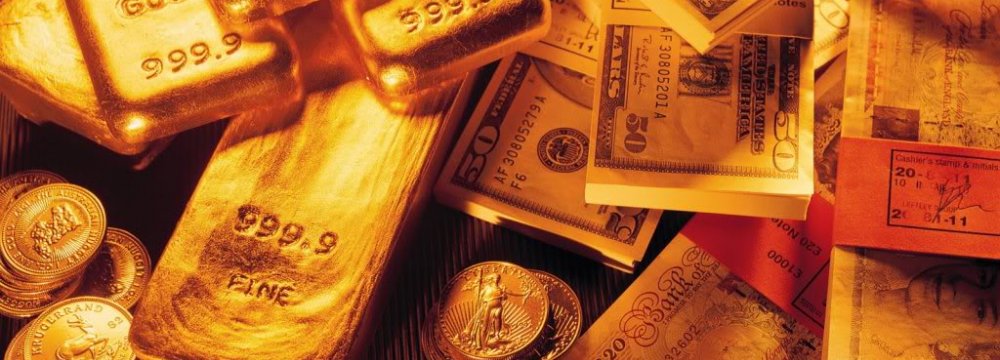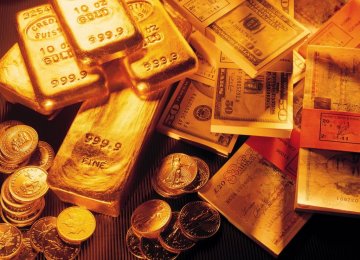The Azadi gold coin is set for a drop on Saturday and Sunday before Iran's market takes a two day break on Monday as Iranians mark Ashura, mourning the martyrdom of Imam Hussein and his companions at Karbala. The Financial Tribune expects a sell-off as Iranian investors respond to Friday's fall in gold's price, due to robust US economic data and stronger dollar. The dollar is set to gain further ground as well.
Gold fell by 2.8 percent to $1164.14 per ounce by 13:15 GMT on Friday, as solid growth data from the US, a strengthening greenback amidst fears of an early rate hike and triggering of stop-loss orders as gold broke through the key $1180.50 level, drove down demand for the precious metal.
Bullion had its worst weekly decline since June 2013, falling by $66.18 or 5.3 percent to as low as $1161.01 per ounce on Friday, lowest since July 2010, before recouping a small part of its losses as low prices spurred some buying.
No Refuge
Azadi, the benchmark gold coin in Iran’s market, is set to take a hit at the market’s open on Saturday, mimicking Friday’s fall in gold’s price, though the fall against the rial may not be as sharp, as it might be cushioned by a rise in the value of the dollar.
The Azadi coin closed at 9,238,000 rials on Thursday, coming down from May’s highs of 10,041,000 rials.
The dollar is at 32,430 rials and is to continue its uptrend against the rial, due to its safe haven status in Iran. While lower than its 33,500 rial high in May, the currency has advanced 8.4 percent in the past year, as the Central Bank of Iran’s low foreign reserves have curtailed its ability to take an active role in the currency market.
Iranian investors are hard pressed to find a refuge for their money. With inflation as high as 19.4 percent last month, the sharp fall in gold, a bearish stock market falling 6.2 percent in the past year and a stagnant housing market, an increase in the inflow of money into the banks is likely as they offer 20 percent annual deposit rates. However, uncertainty over the fate of Iran’s nuclear negotiations will keep the idea of a sudden drop in the value of the rial ever-present.
Gold’s Limit
Gold and silver were hit hard after the dollar rose to a near four-week high against a basket of major currencies on Friday, Reuters reported. The greenback got a boost from strong US gross domestic product data and the Bank of Japan’s surprise move to expand its massive monetary easing that weakened the yen.
The metals were already facing some heat after the US Federal Reserve earlier in the week largely dismissed financial market volatility, a slowdown in Europe and a weak inflation outlook as factors that might undercut progress towards its unemployment and inflation goals.
The hawkish comments and the strong economic data dulled gold’s appeal as a hedge.
The metal’s losses accelerated after the BOJ announcement sent the dollar index soaring to fresh session highs. The dollar rose to the highest in more than six years against the yen. US gold futures also tumbled.
There were big stop loss orders below $1,180.50 an ounce - the triple bottom for gold, said a Hong Kong-based precious metals trader to Reuters. That combined with the strong movement in the dollar against the yen sent gold lower, he said.
The metal is on track for a second straight monthly drop.
Reflecting bearish sentiment, SPDR Gold Trust, the world’s largest gold-backed exchange-traded fund, said its holdings fell 0.16 percent to 741.20 tons on Thursday, the least since Oct. 2008.
Silver, Platinum and Futures
Silver fell nearly 3 percent to $15.94 on Friday - its lowest since February 2010. It is poised for a fourth monthly drop in a row, that’s the worst run since June 2013. An ounce of gold bought as much as 73.3154 ounces of silver today, the most since April 2009.
Spot platinum decreased as much as 1.8 percent to $1,223.05 an ounce, the lowest since Oct. 6. It’s heading for a fourth month of losses that’s the longest stretch since June 2013. Palladium slipped 0.1 percent to $779.67 an ounce.
Gold Futures for December delivery fell as much as 2.7 percent to $1,166.20 an ounce on the Comex in New York, the lowest level since July 2010, before trading at $1,175.80, according to Bloomberg.
Fed and the BOJ
The Fed is weighing the timing of interest-rate increases as other central banks add to stimulus to boost their economies. The Bank of Japan said it’s targeting an 80 trillion yen ($726 billion) expansion in the monetary base, up from 60 to 70 trillion yen before.
“People are generally looking at the direction of the dollar, which moved higher against the yen after the BOJ announcement, although the news itself is neutral for gold,” said Wallace Ng, a Shanghai-based trader at Gemsha Metals Co. to Bloomberg. “A higher dollar depresses prices and sentiment in the gold market was already weak because of the Fed.”
Hit on Two Fronts
Gold rose 70 percent from December 2008 to June 2011 as the Fed bought debt and held borrowing costs near zero percent. Prices slumped 28 percent last year, the most in three decades, on expectation that the central bank will scale back its bond-buying program that was put in place to fuel growth while failing to stoke inflation.
The central bank, which has held its key rate at zero to 0.25 percent since 2008, this week cited an improving job market in deciding to end bond buying, while maintaining a commitment to keep rates low for a considerable time. It also said inflation is running below its 2 percent target.
“Precious metals cratered, hit by a double-whammy of the rather hawkish Fed policy statement, coupled with a stronger-than-expected US GDP report,” Edward Meir, an analyst at INTL FCStone Inc., wrote in a note. “Gold is again confronting the specter of a stronger dollar, rising equity prices and tame inflation, a trifecta that does not bode well for price prospects going into 2015.”
Limited Support
Gold failed to get any support from the Asian physical markets, a factor that could likely push it to further lows. Physical demand usually provides a floor to dropping prices.
Buyers in top consumer China failed to emerge despite the drop below $1,200. Gold of 99.99 percent purity on the Shanghai Gold Exchange - the main platform for physical trades in the country - sank as much as 3.1 percent to 230.05 yuan per gram ($1,172.35 an ounce), the lowest level this year, Bloomberg reported. Volumes tumbled to a one-month low on Friday.
Premiums on the Shanghai Gold Exchange slipped on Friday to less than $1 an ounce, occasionally dropping to a discount against the global benchmark. Premiums ranged between $1 and $2 on Thursday. The lower premiums underscore the soft appetite for gold in China after record consumption last year, according to Reuters.
China’s gold consumption tumbled 21.4 percent year-on-year in the first nine months of the year to 754.8 tons, the China Gold Association said in the statement on Friday.
$1,000 Prospect
The collapse of oil prices into a bear market amid rising global supplies has also cut inflation concerns. The chances of bullion dropping to $1,000 are increasing as cheaper energy “means lower inflation and adds to the bearish gold story,” said Michael Haigh, head of commodities research at Societe Generale SA, who correctly forecast the metal’s 2013 rout.
The bank isn’t alone in predicting more losses for gold, which is Morgan Stanley’s least preferred metal. Jeffrey Currie, Goldman Sachs Group Inc.’s head of commodities research who also correctly forecast 2013’s slump, said last month that the worst isn’t over yet for gold. He expects prices to drop to $1,050 by the end of year.
“We hold a bearish view on gold, considering a recovering US economy and expectations of higher rates,” said Chen Min, a precious metals analyst at Jinrui Futures in Shenzhen to Reuters. “In the long term, we believe gold is likely to break closer to $1,000,” showing the view is also held in Asia.





